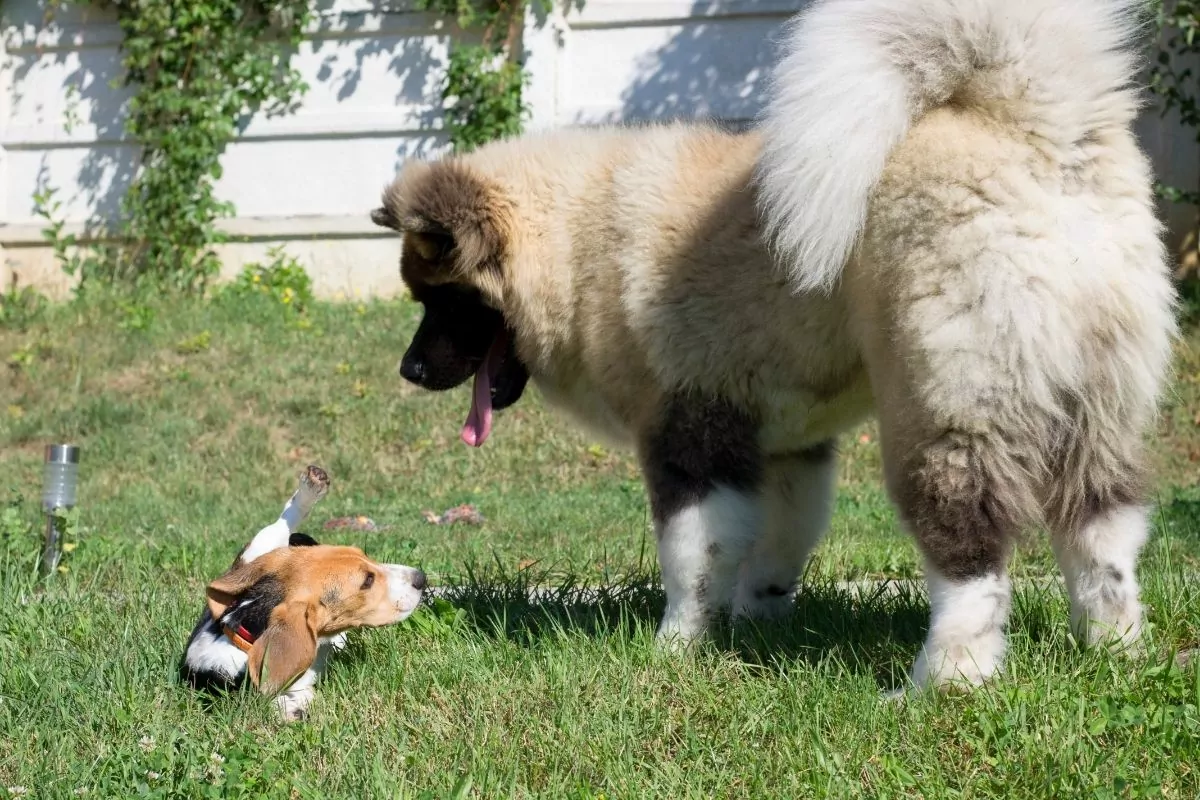How do Dogs Show Dominance?
Dominance is a behavioral trait that some dogs choose to use when interacting with others (e.g., dogs, humans, and other animals). Knowing how to stop dog dominance behavior is essential, as any dog can display dominance at any point if the dog feels the need to do so.

5 Effective Ways of Dealing with Dominant Dog Behavior
It is challenging to establish the best way to effectively communicate and interact safely with dogs showing dominance. They are unlikely to appreciate or accept you if you interact with them the same way as the way you interact with non-dominant dogs.
There are effective ways to approach dominant dogs:
1. Stay Calm
Keep calm and do not respond to undesired behaviors from your dog. If you verbally or physically respond, your dog would likely register your response as a sign of active participation, and this would lead to the continuation or worsening of its behavior.
2. Be Assertive
This is important for getting your message across. Unclear and confusing gestures, movements, and sounds can be scary for dogs, and dominant dogs can respond dramatically out of fear.
3. Establish Rules for People to Follow
Set rules that will help break a habit of your dog’s dominant behavior, and essentially modify that behavior into a more acceptable and manageable one through behavioral modification. For example, if a dog growls and snaps at people whenever they are on a sofa, then the ‘no dogs on sofa’ policy can be one of the rules that everybody in the household must follow.
4. Do Not Force Them to Interact
Unless it is a medical emergency, do not approach to interact if your dog is refusing to interact and showing signs that they want to be left alone. Let your dog come to you on their terms and reward their behavior if they come to you in a calm submissive, nonthreatening manner.
5. Give the Dog a Job
Offer energy-consuming tasks that their excess energy is well-used up focusing on those tasks. For example, you can take your dog to agility or obedience training, which offers physical and mental exercises and an opportunity for you and your dog to strengthen the relationship.
What Does Dog Dominance Aggression Mean?
Some dogs will challenge their owners or other dogs for dominance. They might growl, bark, snap, lunge or bite in response to behaviors they interpret as gestures of dominance. This could be petting, speaking loudly at them, sudden movements, taking away items they consider theirs, embracing, and many others.
Signs of Dominance in Dogs
- Resource-guarding (e.g., food, toys, bedding, territory)
- Aggression (e.g., growl, stare, snap, bark)
- Ignore/resist obeying commands
What to do if Your Dog Displays Dominance Aggression
The first thing you need to do in a situation where your dog is displaying dominant aggression is to secure the safety of everybody involved. Give your dog a space by creating a distance that is far enough that they can be left alone and cannot have any physical contact with others. Remove people and animals that do not need to be present from the area.
The dog’s activities should be limited by confining the area or using a gentle leader or muzzle. If a lead or a muzzle is used, the dog must be supervised the whole time.
Stay calm and use a soft, friendly tone whenever you speak at and around them. Ideally, you want to keep your verbal interactions with your dog brief and minimal. In this way, you would avoid encouraging your dog’s dominant behaviors and teaching them that they would not get any response from you by acting aggressive, but you will still be within their view the entire time.
Once your dog seems to calm down (after however long it takes), try moving closer to them to check their reaction. If your dog responds positively, reward that behavior with a treat or a short verbal compliment to encourage the response.
Read the body language your dog is showing and if it does not respond well to your move, then do not proceed further and wait until they are more accepting. You may leave them unsupervised if this happens at your house, and they are in a confined area with limited access to the rest of the house. Never leave them unsupervised when your dog is in the public areas.
How to Stop Dog Dominance Behavior
A long-term/a permanent solution to stop dominance behavior is behavioral modification. Behavioral modification aims to change dogs’ undesired and/or harmful behaviors with more desirable, safe, and acceptable behaviors that help heighten their quality of life.
Behavioral modification is a lengthy process that requires a lot of commitment and patience. It is certainly not an overnight training that magically resolves the problematic behavior.
There are various techniques you can use to modify the behavior. Habituation, extinction, desensitization, counter-conditioning, response substitution, and shaping are commonly mentioned techniques that you will probably encounter if you search online.
It is best to consult with professionals in the relative field, such as canine behavior consultants, obedience training providers, and/or veterinarians, before beginning any modification training.
Veterinarians can rule out any medical issue your dog might have if your dog’s aggression/dominance comes from any underlying medical problem. The behavior may minimize or cease once the medical issue is resolved or properly managed.

Why Growling is NOT Always a Bad Thing
Dogs use growling to warn others that there is a problem that requires a solution. A dog growling at you might mean that they perceive you as the problem. They are trying to figure out how to act, and this is when people label growling behavior as bad behavior. If a dog is looking at something and growling simultaneously, you would appreciate the dog for alerting you.
When Does Dog Dominance Behavior Start?
Dominance behavior usually does not begin to show until dogs reach their sexual maturity, which is anywhere between 15 and 36 months of age. They may show dominance-like behaviors during play fights and interactions when they are younger, but those are play/prey driven, and it is not usual for puppies to show signs of dominant aggression.
Incorrect Obedience Behavior is the Start of Dog Dominance Behavior
It is the owners’ (or handlers’) responsibility to teach their dogs acceptable manners and rules. If you are not familiar with training puppies, it might be a good idea to research canine behaviors and/or sign up for a puppy school or obedience training course before you begin the training.
Training your dog incorrectly can fail to master desired behavior and may accidentally advocate wrong behavior that you were trying to change.
Step-by-Step Instructions on Training a Dominant Bitch
1. Identify Bad Behaviors and Inconsistent Rules
Make a list of the behaviors that you would like to change. Write down the reason
you consider them as destructive behaviors.
2. Identify the Reason for the Listed Bad Behaviors
Consult with professionals to rule out any medical issues and identify any part that allowed the behaviors to happen. The bad behaviors may be hormone-induced, and your veterinarian may recommend de-sexing your dog.
3. Set an Achievable Goal of the Training
You should always start with basic training and gradually build up to a more complex one. You can always set an ultimate goal that may sound impossible but remember to have less challenging, achievable goals to begin with.
No training can be completed overnight. Therefore, you must be very patient and be committed fully to providing training regularly, twice or three times a day, depending on your lifestyle.
4. Positive Reward Training
Training should be fun to keep your dog engaged and encouraged to do more. Do not punish your dog for bad behaviors or for not completing your commanded tasks. Instead, reward your dog for good behaviors.
In this way, you are changing its mindset on certain behaviors. They would want to display behaviors that it knows it will get rewarded for.
Theories and Misconceptions Around Dog Dominance Behavior
Traditionally, it was commonly believed that you need to ‘show who the boss’ is or ‘be the alpha’ of your dogs to train them and listen to your command. This ideology was based on the wolf pack hierarchy system theory that each wolf pack consists of one alpha and the rest of the pack follows that leader and aggression for dominance is a part of its normal lifestyle.
Recent studies, however, found that wolf packs are very much like human families, where each pack has organized social hierarchies, and there is little to no aggression for dominance. They prefer a herd (tight-knit) group mentality instead. The aggressive behaviors within the pack can cause disorganization and reduce their ability to survive.
Suppressing the dominant behavior of your dog by you being ‘The alpha dog’ is not the same as changing your dog’s behavior or your dog’s mindset. For example, your dog may stop the undesired behavior out of fear of possible consequences and punishment but will not change the dog’s desire to be dominant if an opportunity arises.
Also, being ‘the boss’ means your dog is likely to consider you as a dangerous creature that must be avoided or fought off.

Conclusion
Dominance behavior is one of the problematic behaviors that is commonly reported in our canine friends. Dominance can be displayed by any adult dog and can have serious effects on the welfare of the dogs and people who are involved if not dealt with properly.
Understanding dominance behaviors and recognizing them and their causal factors would help effectively deal with those behaviors. These behaviors can be modified through the proper behavioral training and resolving any underlying issues with owners/handlers fully on board.
